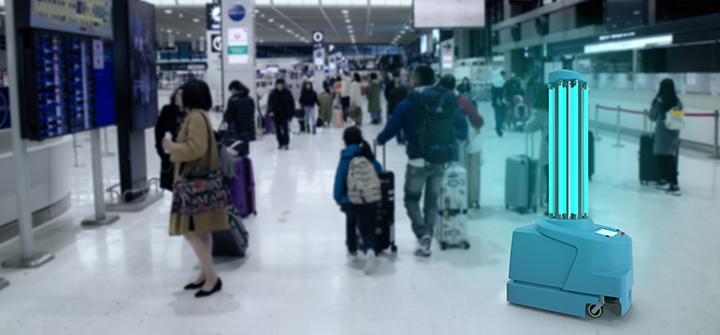
The ASUS IoT-powered robot: Delivering hands-free sanitization in a post-pandemic world
The COVID-19 pandemic caught the planet unprepared. As populations globally move to the recovery and rebuilding phase, the importance of public health is at the fore. Governments and organizations around the world are investing in preventative measures as never before. Technological solutions are playing a key part in this new dawn for epidemiological monitoring and control. Read on to learn how ASUS IoT is aiding innovation in this area.

The problem
Maintaining good hygiene in high-footfall areas
While COVID-19 is a virus that was previously unknown to humanity, scientists already understand that it is transmitted via respiratory droplets, be they from coughs, sneezes or even just the breathing of an infected person. Contact with fomites is also a significant transmission vector, as it is known that the virus may survive on surfaces for several days. It is therefore vital that environments are kept clean to prevent contact with any virus-laden droplets.
A respected systems integrator (SI) was tasked by its own client – a well-known, multinational electronics company – with creating a robotic cleansing system to sanitize a diverse range of environments, from supermarkets to hubshospitals. Such environments have naturally high footfalls, and keeping them clean is traditionally a highly -labor-intensive task. Moreover, the very process of sanitizing these areas places cleaning staff at higher risk of contracting the virus.
To bolster its own expertise, and to help with the build, the SI turned to ASUS IoT.
The solution
An autonomous sanitization system, empowered by ASUS IoT
The SI set to work engineering a robotic system that employs light from high-energy, short-wavelength ultraviolet (UVC) lamps to provide fast, effective and non-contact disinfection of surfaces – a process known as ultraviolet germicidal irradiation.
ASUS IoT collaborated with our customer, the SI, to find the right solution to manage and control this robotic sanitization system. The SI settled on the ASUS IoT C582S-IM-AA, a 3.5-inch single-board computer (SBC), because it offered the necessary size, thermal and performance properties for the envisaged autonomous sanitization system.
With C582S-IM-AA at its core, the disinfection robot begins by mapping the working environment. It then navigates between particular waypoints, emitting sanitizing UVC light as it travels. A dosimeter used during the testing phase ensures a safe-but-effective level of emissions.
The outcome
Fast, effective cleaning for a safer world
Preventing the spread of COVID-19 demands proactive strategies. The sanitization robot built by the SI in collaboration with ASUS IoT, and powered by ASUS IoT hardware, is designed to help keep the disease at bay.
The end customer reports that the user interface of the robotic sanitation system is both friendly and easy to navigate. It enables remote control of the machine via portable devices, such as smartphones and tablets, and makes it easy for staff to monitor status.
The robot itself is equipped with 3D visual-identification technology, along with ultrasonic, gyroscopic and other sensor technologies – minimizing the risk of accidental human exposure to UVC light. It is able to accomplish high-precision laser mapping for urban locations, obstacle recognition, autonomous navigation and obstacle avoidance for complex indoor scenes, and has a built-in full-coverage, path-planning algorithm that the robot to vacuum the entire mapped area on its own while providing a manual mode for simple or more comprehensive ground vacuuming. Depending on the particular environment and its size, full sanitization typically takes around 15 to 30 minutes.
The first batch of sanitization robots are scheduled to ship in April 2021, and they will be set to work to keep us all safer – in retail environments, healthcare settings, commercial premises and more.
